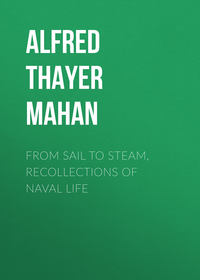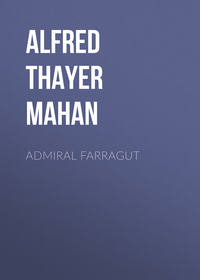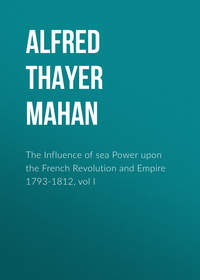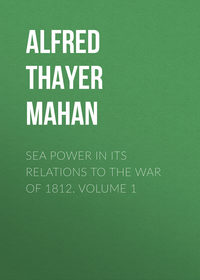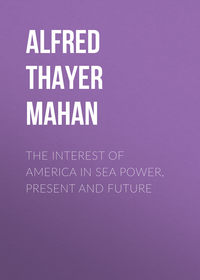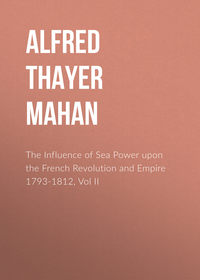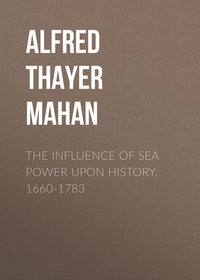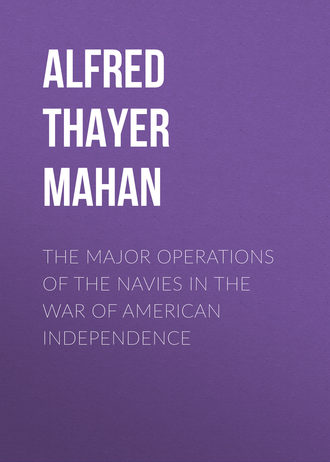 полная версия
полная версияThe Major Operations of the Navies in the War of American Independence
While these things were passing, Howe's triumph was marred by the news of Burgoyne's surrender on the 17th of October. For this he could not but feel that the home government must consider him largely responsible; for in the Chesapeake, too late to retrieve his false step, he had received a letter from the minister of war saying that, whatever else he undertook, support to Burgoyne was the great object to be kept in view.
During the operations round Philadelphia, Sir Henry Clinton in New York had done enough to show what strong probabilities of success would have attended an advance up the Hudson, by the twenty thousand men whom Howe could have taken with him. Starting on the 3d of October with three thousand troops, accompanied by a small naval division of frigates, Clinton in a week had reached West Point, fifty miles up the river. The American fortifications along the way were captured, defences levelled, stores and shipping burned; while an insignificant detachment, with the light vessels, went fifty miles further up, and there destroyed more military stores without encountering any resistance worth mentioning. Certainly, had Howe taken the same line of operations, he would have had to reckon with Washington's ten thousand men which confronted him on the march from the Chesapeake to Philadelphia; but his flank would have been covered, up to Albany, by a navigable stream on either side of which he could operate by that flying bridge which the presence and control of the navy continually constituted. Save the fortifications, which Clinton easily carried, there was no threat to his communications or to his flank, such as the hill country of New Jersey had offered and Washington had skilfully utilised.
The campaign of 1777 thus ended for the British with a conspicuous disaster, and with an apparent success which was as disastrous as a failure. At its close they held Narragansett Bay, the city and harbour of New York, and the city of Philadelphia. The first was an admirable naval base, especially for sailing ships, for the reasons given by Rodney. The second was then, as it is now, the greatest military position on the Atlantic coast of the United States; and although the two could not communicate by land, they did support each other as naval stations in a war essentially dependent upon maritime power. Philadelphia served no purpose but to divide and distract British enterprise. Absolutely dependent for maintenance upon the sea, the forces in it and in New York could not coöperate; they could not even unite except by sea. When Clinton relieved Howe as commander-in-chief, though less than a hundred miles away by land, he had to take a voyage of over two hundred miles, from New York to Philadelphia, half of it up a difficult river, to reach his station; and troops were transferred by the same tedious process. In consequence of these conditions, the place had to be abandoned the instant that war with France made control of the sea even doubtful. The British held it for less than nine months in all.
During 1777 a number of raids were made by British combined land and sea forces, for the purpose of destroying American dépôts and other resources. Taken together, such operations are subsidiary to, and aid, the great object of interrupting or harassing the communications of an enemy. In so far, they have a standing place among the major operations of war; but taken singly they cannot be so reckoned, and the fact, therefore, is simply noted, without going into details. It may be remarked, however, that in them, although the scale was smaller, the Navy played the same part that it now does in the many expeditions and small wars undertaken by Great Britain in various parts of the world; the same that it did in Wellington's campaigns in the Spanish peninsula, 1808-1812. The land force depended upon the water, and the water was controlled by the Navy.
CHAPTER IV
WAR BEGINS BETWEEN FRANCE AND GREAT BRITAIN. BRITISH EVACUATE PHILADELPHIA. NAVAL OPERATIONS OF D'ESTAING AND HOWE ABOUT NEW YORK, NARRAGANSETT BAY, AND BOSTON. COMPLETE SUCCESS OF LORD HOWE. AMERICAN DISAPPOINTMENT IN D'ESTAING. LORD HOWE RETURNS TO ENGLAND.
1778
The events of 1777 satisfied the French government that the Americans had strength and skill sufficient to embarrass Great Britain seriously, and that the moment, therefore, was opportune for taking steps which scarcely could fail to cause war. On the 6th of February, 1778, France concluded with the United States an open treaty of amity and commerce; and at the same time a second secret treaty, acknowledging the independence of the late Colonies, and contracting with them a defensive alliance. On the 13th of March, the French Ambassador in London communicated the open treaty to the British government, with the remark that "the United States were in full possession of the independence proclaimed by their declaration of July 4th, 1776." Great Britain at once recalled her Ambassador, and both countries prepared for war, although no declaration was issued. On the 13th of April, a French fleet of twelve ships of the line and five frigates, under the command of the Count d'Estaing,19 sailed from Toulon for the American coast. It was destined to Delaware Bay, hoping to intercept Howe's squadron. D'Estaing was directed to begin hostilities when forty leagues west of Gibraltar.
The British ministry was not insensible of the danger, the imminence of which had been felt during the previous year; but it had not got ready betimes, owing possibly to confident expectations of success from the campaign of 1777. The ships, in point of numbers and equipment, were not as far forward as the Admiralty had represented; and difficulty, amounting for the moment to impossibility, was experienced in manning them. The vessels of the Channel fleet had to be robbed of both crews and stores to compose a proper reinforcement for America. Moreover, the destination of the Toulon squadron was unknown, the French government having given out that it was bound to Brest, where over twenty other ships of the line were in an advanced state of preparation. Not until the 5th of June, when d'Estaing was already eight weeks out, was certain news brought by a frigate, which had watched his fleet after it had passed Gibraltar, and which had accompanied it into the Atlantic ninety leagues west of the Straits. The reinforcement for America was then permitted to depart. On the 9th of June, thirteen ships of the line sailed for New York under the command of Vice-Admiral John Byron.20
These delays occasioned a singular and striking illustration of the ill effects upon commerce of inadequate preparation for manning the fleet. A considerable number of West India ships, with stores absolutely necessary for the preservation of the islands, waited at Portsmouth for convoy for upwards of three months, while the whole fleet, of eighty sail, was detained for five weeks after it had assembled; "and, although the wind came fair on the 19th of May, it did not sail till the 26th, owing to the convoying ships, the Boyne and the Ruby, not being ready." Forty-five owners and masters signed a letter to the Admiralty, stating these facts. "The convoy," they said, "was appointed to sail April 10th." Many ships had been ready as early as February. "Is not this shameful usage, my Lords, thus to deceive the public in general? There are two hundred ships loaded with provisions, etc., waiting at Spithead these three months. The average expense of each ship amounts to £150 monthly, so that the expense of the whole West India fleet since February amounts to £90,000."
The West Indies before the war had depended chiefly upon their fellow colonies on the American continent for provisions, as well as for other prime necessaries. Not only were these cut off as an incident of the war, entailing great embarrassment and suffering, which elicited vehement appeals from the planter community to the home government, but the American privateers preyed heavily upon the commerce of the islands, whose industries were thus smitten root and branch, import and export. In 1776, salt food for whites and negroes had risen from 50 to 100 per cent, and corn, the chief support of the slaves,—the laboring class,—by 400 per cent. At the same time sugar had fallen from 25 to 40 per cent in price, rum over 37 per cent. The words "starvation" and "famine" were freely used in these representations, which were repeated in 1778. Insurance rose to 23 per cent; and this, with actual losses by capture,21 and by cessation of American trade, with consequent fall of prices, was estimated to give a total loss of £66 upon every £100 earned before the war. Yet, with all this, the outward West India fleet in 1778 waited six weeks, April 10th-May 26th, for convoy. Immediately after it got away, a rigorous embargo was laid upon all shipping in British ports, that their crews might be impressed to man the Channel fleet. Market-boats, even, were not allowed to pass between Portsmouth and the Isle of Wight.
Three days after Byron had sailed, Admiral Augustus Keppel also put to sea with twenty-one ships of the line, to cruise off Brest. His instructions were to prevent the junction of the Toulon and Brest divisions, attacking either that he might meet. On the 17th of June, two French frigates were sighted. In order that they might not report his force or his movements, the British Admiral sent two of his own frigates, with the request that they would speak him. One, the Belle Poule, 36, refused; and an engagement followed between her and the British ship, the Arethusa, 32. The King of France subsequently declared that this occurrence fixed the date of the war's beginning. Although both Keppel's and d'Estaing's orders prescribed acts of hostility, no formal war yet existed.
Byron had a very tempestuous passage, with adverse winds, by which his vessels were scattered and damaged. On the 18th of August, sixty-seven days from Plymouth, the flagship arrived off the south coast of Long Island, ninety miles east of New York, without one of the fleet in company. There twelve ships were seen at anchor to leeward (north), nine or ten miles distant, having jury masts, and showing other signs of disability. The British vessel approached near enough to recognise them as French. They were d'Estaing's squadron, crippled by a very heavy gale, in which Howe's force had also suffered, though to a less extent. Being alone, and ignorant of existing conditions, Byron thought it inexpedient to continue on for either New York or Narragansett Bay. The wind being southerly, he steered for Halifax, which he reached August 26th. Some of his ships also entered there. A very few had already succeeded in joining Howe in New York, being fortunate enough to escape the enemy.
So far as help from England went, Lord Howe would have been crushed long before this. He owed his safety partly to his own celerity, partly to the delays of his opponent. Early in May he received advices from home, which convinced him that a sudden and rapid abandonment of Philadelphia and of Delaware Bay might become necessary. He therefore withdrew his ships of the line from New York and Narragansett, concentrating them at the mouth of Delaware Bay, while the transports embarked all stores, except those needed for a fortnight's supply of the army in a hostile country. The threatening contingency of a superior enemy's appearing off the coast might, and did, make it imperative not to risk the troops at sea, but to choose instead the alternative of a ninety-mile march through New Jersey, which a year before had been rejected as too hazardous for an even larger force. Thus prepared, no time was lost when the evacuation became necessary. Sir William Howe, who had been relieved on the 24th of May by Sir Henry Clinton, and had returned to England, escaped the humiliation of giving up his dearly bought conquest. On the 18th of June the British troops, twelve thousand in number, were ferried across the Delaware, under the supervision of the Navy, and began their hazardous march to New York. The next day the transports began to move down the river; but, owing to the intricate navigation, head winds, and calms, they did not get to sea until the 28th of June. On the 8th of July, ten days too late, d'Estaing anchored in the mouth of the Delaware. "Had a passage of even ordinary length taken place," wrote Washington, "Lord Howe with the British ships of war and all the transports in the river Delaware must inevitably have fallen; and Sir Henry Clinton must have had better luck than is commonly dispensed to men of his profession under such circumstances, if he and his troops had not shared at least the fate of Burgoyne."
Had Howe's fleet been intercepted, there would have been no naval defence for New York; the French fleet would have surmounted the difficulties of the harbour bar at its ease; and Clinton, caught between it and the American army, must have surrendered. Howe's arrival obviated this immediate danger; but much still needed to be done, or the end would be postponed only, not averted. A fair wind carried the fleet and the whole convoy from the Delaware to Sandy Hook in forty-eight hours. On the morning of the 29th, as Howe was approaching his port, he spoke a packet from England, which not only brought definite news of d'Estaing's sailing, but also reported that she herself had fallen in with him to the southward, not very far from the American coast, and had been chased by his ships. His appearance off New York, therefore, was imminent.
Howe's measures were prompt and thorough, as became his great reputation. To watch for d'Estaing's approach, a body of cruisers was despatched, numerous enough for some to bring frequent word of his movements, while others kept touch with him. The ships at New York were ordered down to Sandy Hook, where the defence of the entrance was to be made. Clinton, who had been hard pressed by Washington throughout his march, arrived on the 30th of June—the day after Howe himself—on the heights of Navesink, on the seacoast, just south of Sandy Hook. During the previous winter the sea had made a breach between the heights and the Hook, converting the latter into an island. Across this inlet the Navy threw a bridge of boats, by which the army on the 5th of July passed to the Hook, and thence was conveyed to the city.
On the same day the French fleet was sighted off the coast of Virginia by a cruiser, which reached Howe on the 7th; and two days later another brought word that the enemy had anchored on the 8th off the Delaware. There d'Estaing again tarried for two days, which were diligently improved by the British Admiral, who at the same time sent off despatches to warn Byron, of whose coming he now had heard. Despite all his energy, his preparations still were far from complete, when on the morning of the 11th a third vessel arrived, announcing that the French were approaching. That evening they anchored outside, four miles south of Sandy Hook. Howe, who during all these days was indefatigable, not only in planning but also in personal supervision of details, hastened at once to place his vessels according to the disposition which he had determined, and which he had carefully explained to his captains, thus insuring an intelligent coöperation on their part.
The narrow arm of land called Sandy Hook projects in a northerly direction from the New Jersey coast, and covers the lower bay of New York on the south side. The main ship-channel, then as now, ran nearly east and west, at right angles to the Hook and close to its northern end. Beyond the channel, to the north, there was no solid ground for fortification within the cannon range of that day. Therefore such guns as could be mounted on shore, five in number, were placed in battery at the end of the Hook. These formed the right flank of the defence, which was continued thence to the westward by a line of seven ships, skirting the southern edge of the channel. As the approach of the French, if they attacked, must be with an easterly wind and a rising tide, the ships were placed with that expectation; and in such wise that, riding with their heads to the eastward, each successive one, from van to rear, lay a little outside—north—of her next ahead. The object of this indented formation was that each ship might bring her broadside to bear east, and yet fire clear of those to the east of her. In order to effect this concentration of all the batteries in an easterly direction, which would rake the approach of the enemy, a spring22 was run from the outer, or port quarter of every ship, except the leader.23 These springs were not taken to the bow cable or anchor, as was often done, but to anchors of their own, placed broad off the port bows. If, then, the enemy attacked, the ships, by simply keeping fast the springs and veering the cables, would swing with their broadsides facing east. If the enemy, which had no bow fire, survived his punishment, and succeeded in advancing till abreast the British line, it was necessary only to keep fast the cables and let go the springs; the ships would swing head to the east wind, and the broadsides would once more bear north, across the channel instead of along it. These careful arrangements were subject, of course, to the mischance of shot cutting away cables or springs; but this was more than offset by the probable injury to the enemy's spars and rigging, as well as hulls, before he could use his batteries at all.
Such was the main defence arranged by Howe; with which New York stood or fell. In the line were five 64's, one 50, and an armed storeship. An advanced line, of one fifty with two smaller vessels, was placed just inside the bar—two or three miles outside the Hook—to rake the enemy as he crossed, retiring as he approached; and four galleys, forming a second line, were also stationed for the same purpose, across the channel, abreast of the Hook.24 The retreat of these was secure into the shoal water, where they could not be followed. One 64 and some frigates were held as a reserve, inside the main line, to act as occasion might require. The total available force was, six 64's, three 50's, and six frigates. D'Estaing's fleet, in detail, consisted of one 90-gun ship, one 80, six 74's and one 50. Great as was this discrepancy between the opponents, it was counterbalanced largely by Howe's skilful dispositions, which his enemy could not circumvent. If the latter once got alongside, there was little hope for the British; but it was impossible for the French to evade the primary necessity of undergoing a raking fire, without reply, from the extreme range of their enemies' cannon up to the moment of closing. The stake, however, was great, and the apparent odds stirred to the bottom the fighting blood of the British seamen. The ships of war being short-handed, Howe called for volunteers from the transports. Such numbers came forward that the agents of the vessels scarcely could keep a watch on board; and many whose names were not on the lists concealed themselves in the boats which carried their companions to the fighting ships. The masters and mates of merchantmen in the harbour in like manner offered their services, taking their stations at the guns. Others cruised off the coast in small boats, to warn off approaching vessels; many of which nevertheless fell into the enemy's hands.
Meanwhile d'Estaing was in communication with Washington, one of whose aides-de-camp visited his flagship. A number of New York pilots also were sent. When these learned the draught of the heavier French ships, they declared that it was impossible to take them in; that there was on the bar only twenty-three feet at high water. Had that been really the case, Howe would not have needed to make the preparations for defence that were visible to thousands of eyes on sea and on shore; but d'Estaing, though personally brave as a lion, was timid in his profession, which he had entered at the age of thirty, without serving in the lower grades. The assurances of the pilots were accepted after an examination by a lieutenant of the flagship, who could find nothing deeper than twenty-two feet. Fortune's favors are thrown away, as though in mockery, on the incompetent or the irresolute. On the 22d of July a fresh north-east wind concurred with a spring tide to give the highest possible water on the bar.25
"At eight o'clock," wrote an eye-witness in the British fleet, "d'Estaing with all his squadron appeared under way. He kept working to windward, as if to gain a proper position for crossing the bar by the time the tide should serve. The wind could not be more favourable for such a design; it blew from the exact point from which he could attack us to the greatest advantage. The spring tides were at the highest, and that afternoon thirty feet on the bar. We consequently expected the hottest day that had ever been fought between the two nations. On our side all was at stake. Had the men-of-war been defeated, the fleet of transports and victuallers must have been destroyed, and the army, of course, have fallen with us. D'Estaing, however, had not spirit equal to the risk; at three o'clock we saw him bear off to the southward, and in a few hours he was out of sight."
Four days later, Howe, reporting these occurrences, wrote: "The weather having been favourable the last three days for forcing entrance to this port, I conclude the French commander has desisted." It is clear that the experienced British admiral did not recognise the impossibility of success for the enemy.
After the demonstration of the 22d, d'Estaing stood to the southward, with the wind at east. The British advice-boats brought back word that they had kept company with him as far south as the Capes of the Delaware, and there had left him ninety miles from land. When their leaving freed him from observation, he turned, and made for Narragansett Bay, an attack on which, in support of an American land force, had been concerted between him and Washington. On the 29th he anchored three miles south of Rhode Island, and there awaited a suitable moment for forcing the entrance.
Narragansett Bay contains several islands. The two largest, near the sea, are Rhode Island and Conanicut, the latter being the more westerly. Their general direction, as that of the Bay itself, is north and south; and by them the entrance is divided into three passages. Of these, the eastern, called Seakonnet, is not navigable above Rhode Island. The central, which is the main channel, is joined by the western above Conanicut, and thus the two lead to the upper Bay. The town of Newport is on the west side of Rhode Island, four miles from the main entrance.
On the 30th of July, the day after the French fleet had arrived, two of its ships of the line, under command of the afterwards celebrated Suffren, went up the western channel, anchoring within it near the south end of Conanicut. One of them, as she passed, was hulled twice by the British batteries. At the same time, two frigates and a corvette entered Seakonnet; whereupon the British abandoned and burned a sloop of war, the Kingfisher, 16, and some galleys there stationed. The British general, Sir Robert Pigot, now withdrew his detachments from Conanicut, after disabling the guns, and concentrated the bulk of his force in the southern part of Rhode Island and about Newport. Goat Island, which covers the inner harbour of the town, was still occupied, the main channel being commanded by its batteries, as well as by those to the north and south of it upon Rhode Island. On the 5th of August, Suffren's two ships again got under way, sailed through the western passage, and anchored in the main channel, north of Conanicut; their former positions being taken by two other ships of the line.26 The senior British naval officer, seeing retreat cut off both north and south, now destroyed those ships of war27 which could not enter the inner harbour, sinking two between Goat and Rhode Islands, to prevent any enemy passing there. Five transports also were sunk north of Goat Island, between it and Coaster's Harbour, to protect the inside anchorage in that direction. These preliminary operations cost the British five frigates and two sloops, besides some galleys. Guns and ammunition taken from them went to increase the defences; and their officers and crews, over a thousand in number, served in the fortifications.

Narragansett Bay
On the 8th of August the eight remaining French ships of the line ran the batteries on Rhode and Goat Islands, anchoring above the latter, between it and Conanicut, and were rejoined there by the four previously detached to the western passage. Ten thousand American troops having by this time crossed from the mainland to the northern part of Rhode Island, d'Estaing immediately landed four thousand soldiers and seamen from the fleet upon Conanicut, for a preliminary organisation; after which they also were to pass to Rhode Island and join in the operations. For the moment, therefore, the British garrison, numbering probably six thousand men,28 was hemmed in by vastly superior forces, by land and by water. Its embarrassment, however, did not last long. On the following morning Lord Howe appeared and anchored off Point Judith, seven miles from the entrance to the Bay, and twelve from the position then occupied by the French fleet. He brought a stronger force than he had been able to gather for the defence of New York, having now one 74, seven 64's, and five 50's, in all thirteen of the line, besides several smaller vessels; but he still was greatly inferior to opponent, by any rational mode of naval reckoning.




